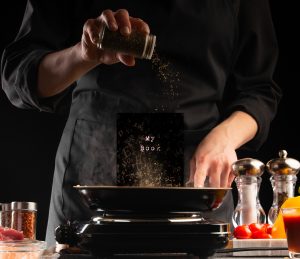FICTION AS A CULINARY ART By Christina Hamlett
FICTION AS A CULINARY ART
By Christina Hamlett
 I was in elementary school when I first realized there was a correlation between cooking and my favorite hobby—reading. I couldn’t really have told you who was bringing all these wonderful tomes to the neighborhood bookmobile every week; like meals at our house, they simply appeared when needed.
I was in elementary school when I first realized there was a correlation between cooking and my favorite hobby—reading. I couldn’t really have told you who was bringing all these wonderful tomes to the neighborhood bookmobile every week; like meals at our house, they simply appeared when needed.
Nonetheless, I knew early on which ones I couldn’t get enough of and which ones left me feeling about as enthused as—well, encountering Brussels sprouts. Just like consuming a meal, there was a finite amount of time allocated to get through each one before you could have another. It was considered cheating to skip ahead to the end (like eating dessert first), tempted as one might be. Likewise, a first chapter (or first bite) which you had to chew on for way too long or had a hard time swallowing didn’t portend well for the rest of the story.
YOU’RE INVITED
When I moved to my first studio apartment at 19, my career leanings were torn between writing and acting. What I couldn’t have predicted was how the company of my fellow actors would be such an influence on my future approach to the craft of writing. That I was the only one who wasn’t still living at home or with roommates made my address the destination of choice after late-night rehearsals. Struggling performers, musicians and writers that we were, we agreed my minimalist kitchen could be used to refuel our energy as long as everyone pitched in on buying groceries and finding recipes. Within the first six months I learned:
- Actors—like individual ingredients—have unique talents to bring to the table but you can’t just throw them all out on stage without any script and expect a dazzling and cohesive result.
- Actors and audiences are like cats. Once you put treats out to attract them, they’re going to expect you to keep the bowl filled. Constantly.
- The three-act structure of a story is like a three-course menu at a formal dinner. The first third is to whet the appetite, the second is to spice it up, and the third is to achieve the push-back-from-the-table satisfaction that everything was perfect.
Lesson: If your soup is stone cold and your salad is limp, how much excitement do you really think you’ll be able to muster for your signature rack of lamb? Remember that the next time you tell someone, “Things don’t really start happening in my book until page 47.”
UPSTAGED BY POTATOES
In my 16 years as an actress and director, I came to appreciate that certain personalities generate a combustible—and sometimes not altogether pleasant—result. Some are born to the ranks of stardom because of their overpowering presence; others—because of their ability to amicably blend in—are meant to be supportive side dishes. Believe me, nothing spells disaster faster than a side dish which suddenly decides to hog center stage. I recall one particular evening in which my costume designer whipped up an ambitious platter of mashed potatoes so reminiscent of the scene from Close Encounters of the Third Kind that nobody remembered my main dish. I was tempted not to invite him back except he would have taken all of our costumes with him.
Lesson: If in the course of writing your plot you find you’re starting to give more lines and back-story to a minor character, you may need to rethink whether your menu is featuring the wrong entree.
GENRE FUSION
What a reader or audience experiences in the opening chapters or scenes is what they’ll expect to see maintained for the rest of the tale. If you start out with Chinese appetizers and suddenly shift to Hungarian goulash, your guests will react with alarm. Having supplied them with chopsticks, blue and white porcelain plates and thimbles of sake, their anticipation—and rightfully so—is that the meal will remain Asian from start to finish.
That same consistency is crucial if you’re cooking up a new plot. Time and again, I’ve read contest submissions which open with doofy and unabashed hilarity and then segue to bioterrorism and graphic violence. I’m never sure whether the writer got bored with the initial tone or simply reverted to the unsophisticated taste buds of childhood and made himself a sandwich of peanut butter, tuna fish and spaghetti. Just as beginning cooks need to try different cuisines and methods in order to perfect their best dishes, writers need to dabble in a variety of genres and styles in order to discover their best voice, especially if they ever plan on entertaining someone other than themselves.
Lesson: Do not attempt experimental genre pairings until you have mastered the basics and understand complementary matches. Indian and Mexican recipes, for example, share a similar heat that makes them compatible and opens the door to creations such as Pork Vindaloo served in soft tacos. On the flip side, “Jerk Tofu” should probably not be attempted anytime soon.
TIMING IS EVERYTHING
During my theater days, I frequently found myself onstage with actors who either rushed into a scene prematurely or else missed their cue and left the rest of us awkwardly ad-libbing until they showed up. When I began cooking, the biggest challenge was to get everything to come out at the same time. Writing proved to be even harder.
Either I’d introduce a character too soon and then not have anything for him to do for long stretches or I’d realize I needed to quickly invent someone new to impart information none of the existing characters already had. It all gets back to the kitchen and having your ingredients assembled at the outset to make sure you have everything you need before things start heating up. Imagine what dolts we all felt like at our opening night beef stroganoff party when we found out our leading man—swept up in the promise of great reviews for his performance—forgot to pick up the beef.
Lesson: Even if you eschew outlines, story maps and character bios, they’re necessary elements insofar as properly folding in foreshadowing, dolloping in danger and stirring up a nice finishing sauce.
CONCLUSION
If you want to please the demanding palates of agents and publishers:
- There will be times when they demand a taste of everything you know how to do. (Be versatile!)
- There will be times when they keep ordering the same thing over and over because it’s the functional equivalent of “comfort food”. (You’ll be bored but you’re still bringing home the bacon.)
- There will also be times when they send your creations back to the kitchen, and say “Bleah!” (Go cook up something else.)
The bottom line? If you can’t stand the heat, stay out of the kitchen.
—
Former actress and theatre director Christina Hamlett (who is also a gourmet chef) is an award-winning author of 48 books, 268 stage plays and squillions of articles. Her new UK cozy mystery series is available on Amazon and Barnes and Noble. The latest addition to that lineup is A Little Poison in Paisley. Learn more about her work at www.authorhamlett.com.
A LITTLE POISON IN PAISLEY, Christina Hamlett
 What could be more romantic than exchanging marriage vows in Scotland on a snowy morning just before Christmas? For Rochelle Reid, the obvious answer would be celebrating her own wedding day with Jon. Instead, the two of them find themselves invited to Paisley to watch his childhood crush marrying into a moneyed family. Yet all is not quite as perfect as it seems at Granndach Manor. Before the first course is half-finished at the elegant dinner the night before, a member of the bridal party is not only dead but Jon is also the first one to discover the body. Whatever wistful hope Rocky may have had to catch the bouquet is, alas, supplanted by the quest to catch a killer instead.
What could be more romantic than exchanging marriage vows in Scotland on a snowy morning just before Christmas? For Rochelle Reid, the obvious answer would be celebrating her own wedding day with Jon. Instead, the two of them find themselves invited to Paisley to watch his childhood crush marrying into a moneyed family. Yet all is not quite as perfect as it seems at Granndach Manor. Before the first course is half-finished at the elegant dinner the night before, a member of the bridal party is not only dead but Jon is also the first one to discover the body. Whatever wistful hope Rocky may have had to catch the bouquet is, alas, supplanted by the quest to catch a killer instead.
BUY HERE
Category: How To and Tips























